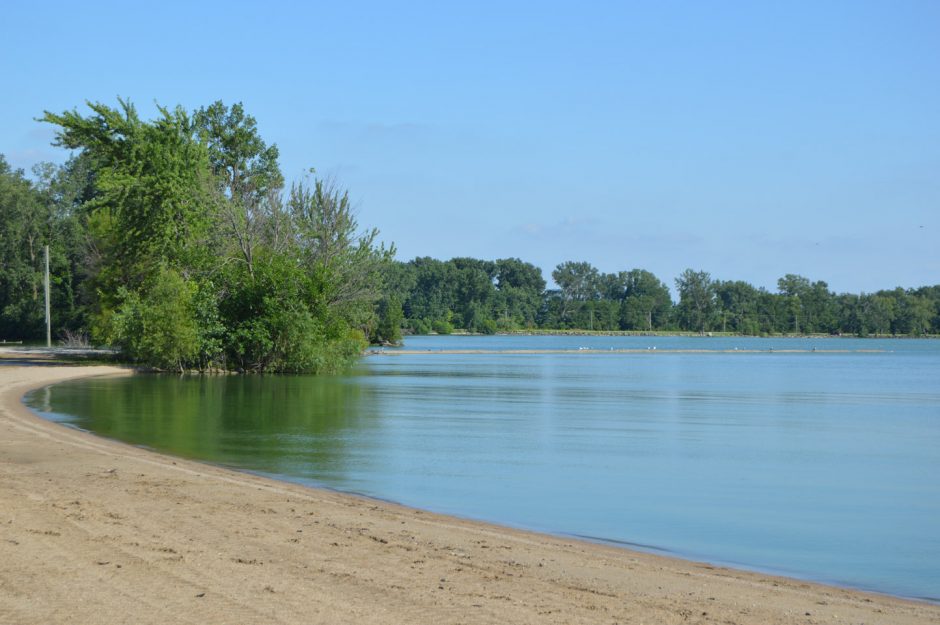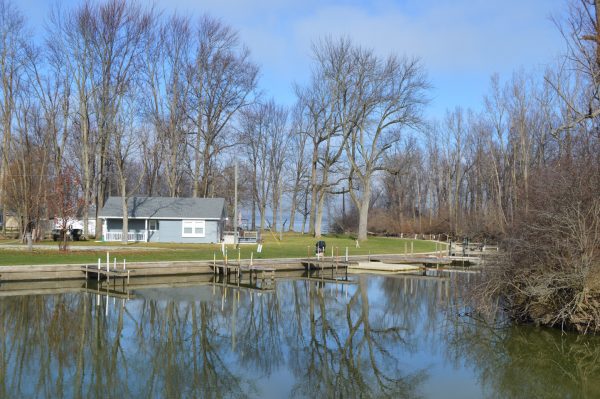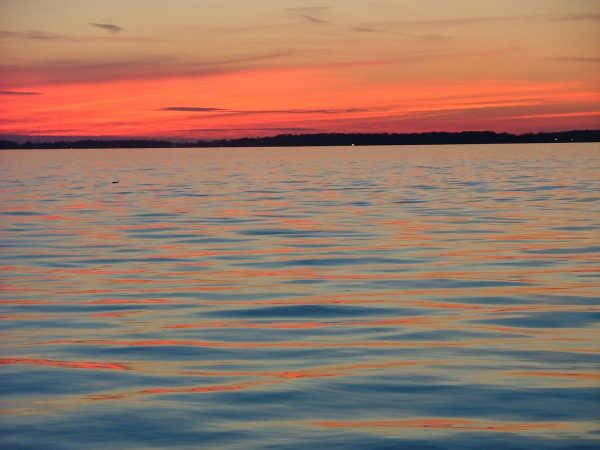Grand Lake St. Marys Management Practices Improving Water Quality

Grand Lake St Marys from Villa Nova. (Credit: By Nyttend [Public domain], from Wikimedia Commons.)
What does it take for a lake to go from being the Environmental Protection Agency’s (EPA’s) poster child for cyanobacteria to genuinely being in recovery and improving year by year? It takes a concerted community effort, best water quality management practices, and patience. At least, that’s what it’s taken for those working to improve the water quality of Grand Lake St. Marys—and recent research proves that all of the effort and patience is paying off.
Stephen Jacquemin, associate professor of biology and research coordinator at the Wright State University Lake Campus, has been spearheading research efforts on the lake for several years, and those efforts go back more than a decade. Jacquemin’s regional watershed work aims to reduce the influx of nutrients into the lake and to improve the quality of the watershed. Jacquemin spoke with EM about the research and how Grand Lake is doing.
A serendipitous starting point
“When you Google harmful algal blooms and cyanobacteria, the EPA website pops up with Grand Lake right on that page,” explains Jacquemin. “It’s quite unfortunate that Grand Lake has sort of found itself right there at the forefront of this because of the high toxin levels. At one point Grand Lake was close to the 99th percentile for cyanobacterial blooms. There are certain times of the year where it’s just you know literally off the charts.”
However, for Jacquemin and his team—and for many longtime environmental advocates—knowing what the problem is means having the ability to generate solutions.
“It’s not an impossible situation; we know the cause, it’s nutrient pollution,” details Jacquemin. “So we can start to look at the potential solutions, and there’s a bunch of them out there. Agriculture is a global engine, not a portion of the economy that you want to shut down, but at the same time, you have to find a way to do it sustainably. And that was one of the big take-home points of the paper.”
The study reveals that the water quality of Grand Lake St. Marys has improved significantly over the past 10 years, and shows with data and graphics how agricultural runoff and other nutrients has affected it. The research also analyzes new best management practices.
“There’s about a decade’s worth of data; the data set that we published on was a long-term data set involving daily water collection that was done by the National Center for Water Quality Monitoring out of Heidelberg University,” Jacquemin describes. “The streams are monitored three times a day. When there’s not a storm event, we just grab the noon sample just because it’s representative. If there is a storm event, you can grab samples at the leading edge of the storm, the middle of the storm, and then the trailing edge of the storm which are always a little bit different in terms of concentration effects.”
The team was fortunate to be starting with a relatively large and complete set of data, both from before the lake was declared impaired and afterward.
“It is actually sort of serendipitous,” remarks Jacquemin. “The National Center for Water Quality is one of the oldest water quality monitoring groups in the country. They have really made it their mission to generate water quality data for the Midwest and the Great Lakes region. They have been doing this since the 1960s. Their goal, when they have the funding, is to have monitoring stations all over the state, because if something changes, how would you ever know it if you didn’t have this pre-data?”
Thus, for the past six decades or longer, the National Center for Water Quality has been trying to establish that baseline. Founding members of the organization had both the foresight to understand what might someday be needed to protect waterways, and the experience of living through the early days of water quality assessment, back when the Cuyahoga River was literally on fire in the late 1960s.

Looking north from Cottonwood Road toward docks on the southern side of Grand Lake St. Marys in northern Franklin Township. (Credit: By Nyttend [Public domain], from Wikimedia Commons.)
“We created a model that would accommodate a number of different covariates,” states Jacquemin. “Water quality data and nutrient data is really kind of problematic from a mathematical perspective. There’s a lot of values that are below detection limits, which means you have a lot of values that are close to zero, but you also have a lot of values that are really really high, and not a lot of values in the middle.”
Because water quality data also follows whatever flow the water offers, the problem is that much more complex. High flow carries very high concentrations with it, while low flow usually brings lower concentrations.
“The problem is the difference between the two when you scale up,” remarks Jacquemin. “It’s not linear; I’m not going to say it’s exponential; it’s not logarithmic; it’s just it’s decidedly unlinear. So when you try and analyze this stuff mathematically you have to account for that, because if you use the wrong test and your test is predicated on some normal distribution pattern or some linear assumption, your data interpretation could be off, even by an order of magnitude; you could also be off by a literal sign.”
The team solved these issues by creating a model that would accommodate these covariates, that could generate results that were mathematically valid and robust. The end result in the study is an overall pre/post view, based on covariation of concentration in the stream of flow with season, with the manure ban period, and with time.
“We were able to compare the two time periods mathematically, and we were also able to do it visually,” adds Jacquemin. “I think that’s the most powerful part of the paper; even if you’re not a stats person, you can just look, and you can understand this work because you can see trends in the graphics.”
Making changes as a community
In the decades before the time of the study, the water quality of Grand Lake St. Marys was so toxic that members of the community often found warnings posted, advising people to avoid all contact with the water. The Grand Lake watershed was designated distressed in 2011. The designation brought local people together to try to crack this problem.
“Grand Lake’s really kind of a unique system; it’s unlike any place I’ve worked,” explains Jacquemin. “I have found that the folks in the communities that surround the lake are some of the most informed, in terms of water quality issues, I have ever been around. You could walk into a restaurant and you could just randomly ask someone about a water quality question or issue that the majority of the public would have no idea what language you’re speaking. But you say those things in this community, you say cyanobacteria, you say nutrient runoff, you say nitrate, people know and it’s interesting. I think that helps a lot.”
Why should communication matter? In part because any effort such as the water quality improvement initiative for Grand Lake includes both mandatory regulations and voluntary measures—both of which are necessary for a successful effort.
“Communication is an important part of this effort because, without it, the effort is just mandatory governmental regulations,” details Jacquemin. “The watershed was declared distressed in 2011, and manure application was therefore forbidden between December 15th and March 1st. In addition, every producer in the watershed must have a nutrient management plan, which is essentially a document that states how much nutrients can and can’t legally be applied to the land, and that’s informed by rigorous soil testing. So those are rules, informed by science, and there are consequences associated with breaking them.”
However, those mandatory measures are really just the beginning when it comes to reducing nutrient runoff into Grand Lake, and both Jacquemin and the members of the community know it.
“There have been many voluntary efforts, like cover crops, riparian zones, buffers, waterways, the newer storage structures, manure transfers,” Jacquemin describes. “Those voluntary efforts would not come without communication. If someone feels attacked or marginalized, they will be less willing to help. We have a couple of community groups, the Lake Improvement Association as well Ag Solutions those are two community groups that do a lot of good when it comes to saying, ‘Hey, there are these opportunities available for conservation, it’s your right to pursue it, talk to us.’”
Looking into the future
How well exactly has it worked—is Grand Lake fixed?
“This study documents some unbelievably important reductions, some over 50 percent,” remarks Jacquemin. “These reductions were most apparent in medium and high flows, which are the most important flows because those are the ones that are the source of the nutrient load. We saw a reduction of between 20 and 60 percent across those—it was really substantial.”
However, although the program is a great success, the lake is still a work in progress.
“But here is the elephant in the room,” states Jacquemin. “We’re not there yet; here’s why. Our starting point was so high, that even though we’ve come down, we are still higher than most. I emphasize again, this is a success story, but we’re not there yet. We have so much work to do in the region, and it’s more than just one person or one university or one producer, it really needs to be a kind of collective effort.”
However, Jacquemin points out the many benefits of research like this, even when the water in question is still above the threshold and retains harmful algal blooms.
“It’s possible that the efforts that are done here can be looked at by others; somebody else can say, gosh we’re not starting that high, but those folks did, maybe we can implement that here,” argues Jacquemin. “And so even if Grand Lake is going to be eutrophic forever, that doesn’t mean it’s worthless, because somebody else might learn something and maybe implement a new practice somewhere else. This was as much runoff as you could get and an amazing reduction.”

Sunset over Grand Lake St Marys. (Credit: By Bruin – originally posted to Flickr as DSCF9646, CC BY 2.0, https://commons.wikimedia.org/w/index.php?curid=10622040)
Another benefit to research and programs like this one is the effect on the community. Especially if you live in a place where there’s frequent negative news about something central to the community, positive news can unite people and solidify commitment to restoration efforts.
“For years and years there was nothing but negative news about this system,” Jacquemin describes. “And it makes people a little bit weary, you know, when it’s constantly gloom and doom. They understand that it’s not going to be fixed overnight. But they’re very excited about the fact there’s some positive progress. This is not a paper that says, we’re out of the woods. It’s a paper that says, hey we’re still really bad, but we’re not as bad, we’ve seen 60 percent drops, we’re on task, let’s keep doing this.”
For people who live near Grand Lake, many of these best practices are visible—another source of pride and evidence of a long-term plan that’s working.
“You can see grass waterways where you didn’t see them before next to the streams,” remarks Jacquemin. “You can see some of the massive wetlands that are being used to filter water before it goes into the lake. We have two wetlands, and there’s another two that are in the works right now. These are artificial, constructed wetlands where the streams get pumped from the stream bed into these wetlands, and then the wetlands percolate into the lake. These wetlands can process like 3 million gallons a day in some cases. I’ll tell you, those can be some of the most powerful advocates for what you’re doing to improve water quality when you can see it. I’m not that different from most people; I may generate a lot of really complex data, but at the end of the day, numbers and data are important but we can’t be ruled by them.”
Will Grand Lake and its community reach the end goal of a pristine body of water? The data can’t tell anyone that—but it certainly proves progress in the right direction.
“I don’t have a time frame, I don’t know when Grand Lake is going to be crystal clear, or even if it ever will be,” adds Jacquemin. “I know that even if it won’t be perfect, that doesn’t mean that it’s not worth it. It’s the natural environment; it’s worth everything.”
And from the perspective of the research scientist, Jacquemin sees work like this as a way to give back—not just to the local community living around Grand Lake, but to the scientific community.
“My lab could not run without undergraduates; I really work hard to get as many undergraduates involved with the project as possible,” states Jacquemin. “I have six or eight undergraduates at any given time working on collecting data, analyzing data, analyzing nutrients, attending conferences, presenting findings, and then they graduate and they go on and they work all over the place. It’s not publications, it’s people that are ultimately going to have the greatest impact, everything else is kind of professional ego. But if we can put students out there, that’s how you actually do something. It’s probably not going to be fixed in our lifetime, but if it’s not, you better be sure that some part of your enthusiasm or some part of your skill set, whatever piece that was, you better be sure that gets into the next group.”
Top image: Grand Lake St Marys from Villa Nova. (Credit: By Nyttend [Public domain], from Wikimedia Commons.)




Pingback: Grand Lake St. Marys Management Practices Improving Water Quality - Lake Scientist
Michael Raymond
June 20, 2020 at 1:08 pm
I and my family grew up on that beautiful lake. I live elsewhere now, but occasionally get back to visit. I am so happy your efforts are helping. We all need to save this planet , there is no plan B.